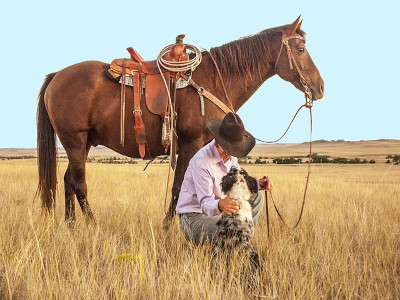Horses have appeared in Palaeolithic cave art from 30 000 B.C.E., but probably back then they were hunted for meat. The clearest evidence of horse use is from 2000 B.C.E. Then the horse was probably used for transportation. It is thought that horses were domesticated in the European Steppes about 3500 B.C.E. Scientists suggest that horses might be domesticated several times, and it might happen in different places as well, not only in the Caspian region. Horses were domesticated because they were used for transportation, agricultural work, and warfare. The Botai culture was probably the first to introduce horseback riding. They used horses to hunt wild horses in northern Kazakhstan from around 3500–3000 BC. Other than horses, Botai also had domesticated dogs. Botai also used horses for their milk. Horseback riding was also adopted by other herding societies in the steppes west of the Ural Mountains. Nowadays, there are different equestrian disciplines like dressage, eventing, jumping, reining, endurance riding, barrel racing, horse racing, and so on.
Newer evidence suggests that horseback riding might have started even earlier, 5000 years ago. This time, scientists took a closer look at human bones to find out when the riding started. In earlier studies, scientists were doing tests on horses’ teeth. They were looking for traces of bitwear. Through the use of scanning electron microscope analysis, it has been determined that this type of wear is distinct from other forms of tooth damage. The earliest evidence of bit wear was found in the Ukraine around 4000 BC.
In these new studies, they found out that there are some marks on the bone structure, which are consequences of frequent horseback riding. These marks or patterns on the skeleton are called “horseman syndrome”. This happens with the bones when they adapt to the biomechanical stress caused by repeated movements. Horseman syndrome causes changes in the thigh bones, pelvis, and lower spine. A group of scientists analyzed more than 200 Bronze Age skeletons and found these changes on several Yamnaya skeletons. In the last century B.C., horseback riding became common, and for example, the wealth of the Scythian warriors was measured in horses. They also buried the horses with them because they taught that the wealth would fallow them in the afterworld.
Botai culture first used horses to make hunting easier. Later, people started using horses to travel faster and longer distances. That allowed people to migrate all over Europe and Asia. It is even said that the wheel was invented because it made horses even more useful to carry more cargo. People also used horses in battles. In Central and East Asia, horses were bred for their meat, and herders travelled with them to find more food for their livestock. Nowadays, horses role in transportation isn’t so big any more. People do it more as a hobby. Today, people use horses for sport, leisure, or as just our big pets. Horses are also the only animals that are used in Olympic games, and they are also considered as athletes.
When horses were first domesticated and used for horseback riding, nobody was thinking about whether it was ethical to ride with them. Animal rights activists have amplified conversation over horseback riding, and they have raised the question: is it proper to use horses the way we do? This problem or question is derived from current beliefs. Nature is idealized, and people like to say that natural way is better. Most of today’s horse breeds would suffer in the wild. After generations of genetic and environmental adaptations, horses need humans to survive. Of course, living conditions are very different in every horse industry, but still, most of the time, the welfare of horses is put first.
In conclusion, it can be said that the discovery suggests that the ability to ride horses provided a significant advantage to societies in Eurasia, leading to increased mobility and cultural transformation. Still, there is a lot of room for interpretation and speculation. Scientists still argue over the question of whether horses were first used to pull chariots in warfare or whether the riding occurred first.

Sources:
https://en.wikipedia.org/wiki/Domestication_of_the_horse
https://www.usef.org/compete/breeds-disciplines
https://www.scientificamerican.com/article/humans-started-riding-horses-5-000-years-ago-new-evidence-suggests/
https://www.cambridge.org/core/journals/antiquity/article/abs/origins-of-horseback-riding/0E114D9C3322618311F2E4C9A228CCA1
https://www.pbs.org/newshour/science/archaeologists-find-evidence-that-horseback-riding-began-at-least-5000-years-ago
https://www.horsejournals.com/popular/rescue-welfare/equestrianism-and-animal-rights
https://www.nationalgeographic.com/animals/article/do-we-finally-know-where-horses-evolved
https://knowablemagazine.org/article/living-world/2022/tale-domesticated-horse
https://edition.cnn.com/2021/10/22/world/domestic-horses-origin-scn/index.html
https://tophorsebackriding.com/blog/a-history-of-horseback-riding/
https://www.topendsports.com/events/summer/sports/animals.htm
